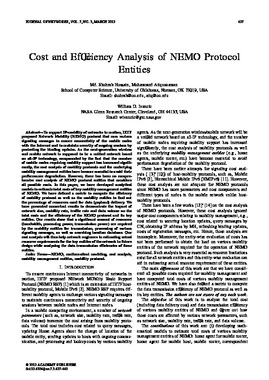| dc.contributor.author | Hossain, Md. Shohrab | |
| dc.contributor.author | Atiquzzaman, Mohammed | |
| dc.date.accessioned | 2014-10-29T17:44:55Z | |
| dc.date.accessioned | 2016-03-30T15:33:05Z | |
| dc.date.available | 2014-10-29T17:44:55Z | |
| dc.date.available | 2016-03-30T15:33:05Z | |
| dc.date.issued | 2012-03 | |
| dc.identifier.citation | M. S. Hossain and M. Atiquzzaman, "Cost and Efficiency Analysis of NEMO Protocol Entities," Journal of Networks, vol. 7, no. 3, pp. 427-440, Mar. 2012. | en_US |
| dc.identifier.uri | https://hdl.handle.net/11244/13397 | |
| dc.description.abstract | To support IP-mobility of networks in motion, IETF proposed Network Mobility (NEMO) protocol that uses various signaling messages to ensure connectivity of the mobile nodes with the Internet and to maintain security of ongoing sessions by protecting the binding updates. As the next-generation wireless and mobile network is supposed to be a unified network based on all-IP technology, compounded by the fact that the number of mobile nodes requiring mobility support has increased significantly, the cost analysis of mobility protocols and the underlying mobility management entities have become essential to avoid their performance degradation. However, there has been no comprehensive cost analysis of NEMO protocol entities that considers all possible costs. In this paper, we have developed analytical models to estimate total costs of key mobility management entities of NEMO. We have defined a metric to compute the efficiency of mobility protocol as well as the mobility entities to find out the percentage of resources used for data (payload) delivery. We have presented numerical results to demonstrate the impact of network size, mobility rate, traffic rate and data volume on the total costs and the efficiency of the NEMO protocol and its key entities. Our results show that a significant amount of resources (bandwidth, processing power, transmission power) are required by the mobility entities for transmission, processing of various signaling messages, as well as searching location database. Our cost analysis will thus help network engineers in estimating actual resource requirements for the key entities of the network in future design while analyzing the data transmission efficiencies of these entities. | en_US |
| dc.language | en_US | en_US |
| dc.subject | Computer Science. | en_US |
| dc.title | Cost and Efficiency Analysis of NEMO Protocol Entities | en_US |
| dc.type | Article | en_US |
| dc.description.peerreview | Yes | en_US |
| dc.description.peerreviewnotes | Peer-reviewed journal article. | en_US |
| dc.identifier.doi | 10.4304/jnw.7.3.427-440 | en_US |
